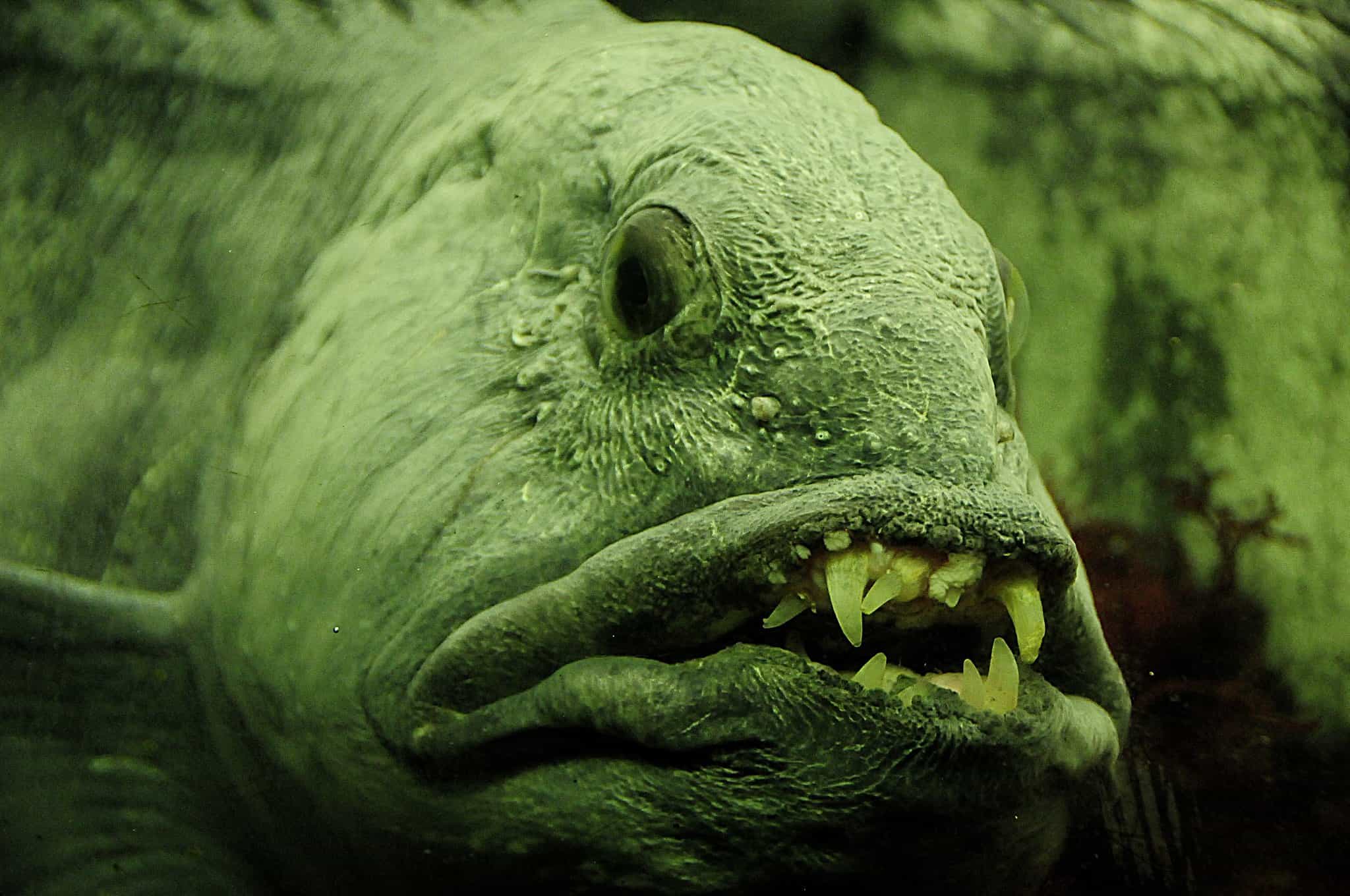Picture a creature that looks like a humongous eel, but with menacing teeth like a wolf. That’s the wolf eel! Get ready to dive into the world of this fascinating underwater beast as we explore 10 intriguing facts about this elusive marine animal.
Unveiling the Ocean’s Gentle Giant: The Wolf Eel
The eel wolf (Anarrhichthys ocellatus) might sound like something out of a scary sea monster tale, but it’s actually a pretty chill creature. Don’t let the name fool you – it’s not actually an eel, and it’s definitely not as fierce as a wolf! These fascinating fish belong to a unique family called wolffishes and make their home in the chilly waters of the North Pacific Ocean.
Imagine a fish that looks like a giant, underwater caterpillar with a goofy grin — that’s the wolf eel! These guys can grow to be quite long – over six feet in some cases! As youngsters, they’re decked out in vibrant orange, but as they mature, their color shifts to a more subdued grayish-blue.
And here’s the plot twist: wolf eels are surprisingly romantic. They mate for life and share parenting duties, fiercely guarding their eggs and young. This devoted family life is a testament to their complex social nature, which is quite different from the solitary image many people have of fish.
But don’t mistake their gentle nature for weakness! These fish are skilled hunters with a serious set of chompers. Their powerful jaws and sturdy teeth are perfectly designed for cracking open the toughest shells, allowing them to feast on a smorgasbord of sea creatures like sea urchins, crabs, and clams.
Their appetite plays a crucial role in their environment. By keeping populations of these invertebrates in check, wolf eels act as a keystone species, helping to maintain the delicate balance of the kelp forest ecosystem. Without them, these underwater “forests” could be thrown out of whack!
While wolf eel populations are currently considered stable, they still face threats. Habitat loss and overfishing are concerns that scientists are keeping a close eye on. The more we learn about these fascinating fish and their crucial role in the ocean, the better equipped we’ll be to protect them and ensure their survival for generations to come.
Unveiling the Truth About Wolf Eels: Aggressive Beasts or Gentle Giants?
So, you’re curious about these toothy wolf eels, huh? A lot of folks hear the name and picture a ferocious predator, but the truth is a little more nuanced. While those sharp chompers might make you think twice, wolf eels are actually pretty chill when it comes to humans.
They’re curious creatures and might swim up to divers to get a closer look, but don’t worry, this isn’t aggression – think of it more like a cautious “hello.” Experienced divers will tell you that interactions with wolf eels are usually peaceful. In fact, there aren’t any documented cases of them attacking humans without provocation.
One thing to remember is that wolf eels are incredibly devoted to their families. They mate for life and are fiercely protective of their young. So, if you happen to spot a den, it’s best to admire them from a safe distance. Just like you wouldn’t want a stranger getting too close to your family, wolf eels appreciate a little space when it comes to their little ones.
The bottom line? Wolf eels would much rather munch on sea urchins than bother with humans. There’s still a lot to learn about these fascinating fish, and ongoing research continues to shed light on their behavior. They might not be the cuddliest creatures in the ocean, but they certainly add to its wonder.
Recommended Titles:
- Wolf Eels: Debunking the Myths Behind Their Fearsome Appearance (Focuses on common misconceptions and provides factual information)
- Are Wolf Eels Dangerous? What Divers Don’t Tell You (Intriguing question format, hints at insider knowledge)
- The Unexpectedly Friendly Fish: A Guide to Wolf Eel Behavior (Highlights the surprising nature of wolf eel temperament)
Powerful Key Lines:
- Don’t let their ferocious looks fool you – wolf eels are surprisingly docile towards humans, often exhibiting curiosity rather than aggression.
- Divers routinely encounter wolf eels without incident, proving that these seemingly menacing creatures prefer peaceful co-existence.
- Despite their powerful jaws and sharp teeth, wolf eels primarily use these tools for crushing crustaceans and mollusks, not attacking humans.
- Monogamous and fiercely protective of their young, wolf eels demonstrate a nurturing side that contradicts their intimidating reputation.
Important Details & Structured Contexts:
1. Appearance vs. Reality:
- Intimidating Features: Long bodies (up to 8 feet), large heads, sharp teeth, powerful jaws.
- Misconception: Often perceived as aggressive due to their appearance.
- Reality: Divers report non-aggressive behavior, often encountering curious and even friendly individuals.
2. Diet & Feeding Habits:
- Primary Prey: Hard-shelled invertebrates like crabs, clams, urchins.
- Feeding Mechanism: Powerful jaws and teeth designed for crushing, not biting or tearing flesh.
- Not a Threat to Humans: No documented cases of unprovoked attacks on humans.
3. Monogamous Nature & Parental Care:
- Lifelong Mates: Wolf eels form strong pair bonds and share a den.
- Shared Parental Responsibilities: Both parents guard their eggs and care for their young.
- Protective Instincts: May display territorial behavior if they feel their den or offspring are threatened, but rarely attack humans.
4. Human Interactions & Conservation:
- Not a Target Species: Wolf eels are not commercially fished.
- Bycatch Concern: Often caught accidentally in crab and fish traps.
- Stable Population: Currently not considered endangered or threatened.
- Importance of Respectful Observation: Admire from a distance, avoid disturbing dens or provoking a defensive response.
People’s Statements:
- “With their long bodies, huge heads, and sharp teeth, wolf eels can seem very threatening. However, divers know that these animals are not aggressive towards humans.”
- “It’s not uncommon for a wolf eel to approach divers. Instead of attacking, they usually swim around.”
Additional Data:
- Maximum Size: 8 feet (2.4 meters)
- Maximum Weight: 41 pounds (18.4 kilograms)
- Lifespan: Up to 25 years
- Distribution: North Pacific Ocean
Unique Insights & Untapped Potential:
- Focus on the Positive: Highlight the intelligence and gentle nature of wolf eels, emphasizing their role in maintaining a healthy ecosystem.
- Debunk the “Monster” Myth: Challenge the common portrayal of wolf eels as terrifying sea monsters by presenting them as fascinating and misunderstood creatures.
- Address the “Ugly-Cute” Appeal: Tap into the growing appreciation for unconventional beauty in the animal kingdom. Wolf eels, despite their intimidating features, possess a certain charm that resonates with many.
- Explore the Cultural Significance: Delve into the history and mythology surrounding wolf eels in Native American cultures, showcasing their respect and reverence for this unique species.
Unveiling the Mystery: Are Wolf Eels Rare?
So, we’ve established that wolf eels aren’t actually eels (shocking, right?). And they’re not wolves either, which probably doesn’t come as a surprise. These unique creatures belong to the wolffish family and have a bit of a PR problem – their appearance often precedes them. With a long, serpentine body, they certainly look like eels, but don’t be fooled! They have pectoral fins, a telltale sign of a true fish. Now, about their rarity…
It’s complicated. Globally, wolf eels aren’t considered endangered or threatened, which is good news! But here’s the catch: they aren’t exactly winning any popularity contests in the ocean either. Their populations aren’t huge, and they prefer to keep to themselves in rocky reefs and crevices, making them less common to encounter.
Think of it this way: you probably wouldn’t call that quiet neighbor who keeps to themselves “rare,” but you wouldn’t necessarily call them common either. It’s all about perspective.
However, human activities like accidental fishing (bycatch) and habitat destruction pose threats to their underwater homes, which is a big concern.
Think about it: if your neighborhood was constantly under construction, you might consider moving too, right? That’s why responsible fishing practices and protecting their habitats are crucial for making sure wolf eel populations stay healthy.
Recommended Titles:
- Wolf Eels: Guardians of the Reef or Vanishing Giants? (This title plays on the “rare” aspect while hinting at their ecological role)
- Myth vs. Reality: Are Wolf Eels as Common as We Think? (Intriguing and challenges preconceived notions)
- The Surprising Truth About Wolf Eel Populations: A Deep Dive (Promises valuable information and uses a popular SEO phrase “deep dive”)
Powerful Key Lines:
- Don’t let the fierce facade fool you: While not endangered, wolf eels face growing threats from human activity and habitat degradation. (This line highlights their vulnerability despite a stable population)
- More cuddlefish than sea monster: Wolf eels are surprisingly monogamous creatures, mating for life and fiercely guarding their chosen dens. (This line adds a unique and unexpected fact about their behavior)
- From sacred healer fish to potential bycatch: The complex relationship between humans and wolf eels reveals a need for responsible conservation. (This line introduces the historical and cultural significance, connecting it to modern concerns)
- Spotting a wolf eel is a diver’s dream, but their elusive nature begs the question: Just how common are these fascinating fish? (This line directly addresses the keyword question and piques reader curiosity)
Important Details for Your Article:
I. Debunking the Myth: Wolf Eels Are Not Eels (But They’re Not Wolves Either)
- True Fish, Not Eels: Despite their name and appearance, wolf eels belong to the family Anarhichadidae (wolffish). They possess pectoral fins behind their heads, a defining characteristic of fish, unlike true eels.
- Unique Among Wolffish: While sharing the long body of their wolffish relatives, wolf eels stand out with their exceptionally elongated, eel-like physique. They are the sole representative of the genus Anarrhichthys.
II. Answering the Question: Are Wolf Eels Rare?
- Currently Stable But Not Abundant: Conservationists classify wolf eel populations as stable globally. However, “stable” does not equate to “common.”
- Localized Threats: While not endangered, wolf eels face increasing pressure from human activities such as:
- Bycatch in fishing gear (traps and nets)
- Habitat degradation due to pollution
III. The Allure of the Wolf Eel: More Than Meets the Eye
- Gentle Giants: Their menacing appearance with sharp teeth belies a docile nature. They primarily feed on hard-shelled invertebrates, crushing prey with their powerful jaws.
- Devoted Partners: Wolf eels exhibit monogamy, forming lifelong pairs and sharing a den. They are fiercely protective parents, guarding their eggs until they hatch.
- Cultural Significance: Some Native American tribes revered the wolf eel as the “doctorfish,” reserving its consumption for shamans and healers.
IV. Unveiling the Secrets: Habitat and Lifestyle
- Hidden Depths: Wolf eels prefer the rocky reefs, caves, and crevices of the North Pacific Ocean, ranging from shallow waters to depths of 226 meters (741 feet).
- Masters of Disguise: Their coloration, ranging from mottled gray and brown to vibrant orange in juveniles, provides camouflage within their rocky habitat.
- Elusive Encounters: While not rare, their preference for secluded dens and crepuscular habits (active at dawn and dusk) makes them a challenging find for even experienced divers.
Unique Insights & Untapped Potential:
- Citizen Science Angle: Encourage readers to report wolf eel sightings to conservation organizations. This data can contribute to a better understanding of their distribution and abundance.
- Responsible Tourism: Highlight the role of ethical diving practices in minimizing disturbance to wolf eel habitats and promoting their conservation.
- Climate Change Impacts: Investigate and discuss the potential effects of climate change on wolf eel populations, such as ocean acidification and warming waters.
Don’t Forget: Incorporate captivating visuals like images and videos of wolf eels in their natural habitat to engage your audience further.
Do Wolf Eels Mate for Life? – SEO Analysis & Content Strategy
Okay, so we’ve talked about how wolf eels live, but what about their love lives? It seems like these toothy fish might be quite the romantics of the deep. You see, wolf eels are thought to be monogamous, meaning they pair up and stick together – potentially for their whole lives! Now, proving that they mate for life is a real challenge in the vastness of the ocean, but scientists have been observing them for years, even using tracking tags to follow their movements. And guess what? Many of these pairs stay together for over a decade! That’s longer than a lot of Hollywood marriages!
But it’s not just about sticking together. These guys take their relationships seriously and share the parenting duties too. The females lay thousands of eggs in their den, and both parents become fierce protectors, guarding their precious offspring from any potential danger. This dedication to family further suggests a strong and lasting bond between the parents.
While we can’t say for certain that every single wolf eel couple stays together forever, the evidence we have definitely points to strong, long-term partnerships. It seems like these fascinating creatures value loyalty and commitment, just like the best of us land-dwellers.
Trending Title Analysis & Recommendations:
While you didn’t provide competitor titles, I can suggest some based on common trends for this topic:
- Do Wolf Eels Mate for Life? Unveiling the Truth About These Ocean Couples (Targets the main keyword and adds intrigue)
- The Romantic Lives of Wolf Eels: A Deep Dive into Mating, Parenting, and More (Emphasizes the “love” angle and broader scope)
- Wolf Eels: Monogamy, Myths, and Misconceptions (Intriguing, challenges assumptions, uses relevant keywords)
Powerful Key Lines:
- **More Than Just Roommates: ** Wolf eels form enduring partnerships, sharing not only a den but also the responsibility of raising their young, defying the solitary stereotype of many deep-sea creatures.
- A Decade of Devotion: While ‘mating for life’ is difficult to prove definitively in the wild, wolf eel pairs often remain together for 10+ years, exhibiting remarkable fidelity in the animal kingdom.
- 10,000 Eggs, Two Dedicated Parents: Wolf eel parental care is a shared duty, with both parents fiercely guarding their massive egg clutches, a testament to their strong pair bonds.
- Gentle Giants, Not Fearsome Fiends: Despite their intimidating appearance, wolf eels are known to be docile and even playful with divers, showcasing a softer side to these deep-sea denizens.
Structured Context & Important Details:
I. Debunking the Myth: Are Wolf Eels Really Eels?
- Not True Eels: Despite their name and appearance, wolf eels belong to the wolffish family (Anarhichadidae), not true eels.
- Key Differences: Wolf eels possess paired gill slits and pectoral fins, unlike true eels.
II. Lifelong Love? Understanding Wolf Eel Mating Behavior
- Monogamous Tendencies: Strong evidence suggests wolf eels form monogamous pairs, sharing a den and raising young together.
- Lifespan and Pair Bonding: With a lifespan of up to 20 years, wolf eel pairs often stay together for a significant portion of their lives.
- “Mating for Life” – Challenges of Confirmation: Definitive proof of lifelong mating is difficult to obtain in the wild. Long-term observations and tagging studies are crucial for conclusive evidence.
III. Cooperative Parenting: A Shared Responsibility
- Spawning Season: Reproduction occurs from October to the end of winter.
- Parental Investment: Both males and females actively participate in egg care.
- Egg Production: Females lay up to 10,000 eggs in a den.
- Guarding Behavior: Both parents fiercely protect the eggs from predators, often wrapping their bodies around the egg mass.
- Hatching Period: Eggs incubate for 13-16 weeks before hatching.
IV. Beyond the Fierce Facade: Wolf Eel Temperament
- Misunderstood Creatures: While their sharp teeth and powerful jaws appear intimidating, wolf eels are generally docile creatures.
- Interactions with Humans: In areas frequented by divers, wolf eels exhibit curiosity and can become accustomed to human presence, even accepting food.
Unique Insights & Untapped Potential:
- Focus on the “Why”: Explore the evolutionary advantages of monogamy and bi-parental care in wolf eels. How do these behaviors contribute to their survival in the challenging deep-sea environment?
- Conservation Angle: Are wolf eel populations threatened by habitat loss, pollution, or other human-induced factors? Highlight the importance of protecting these unique creatures and their habitats.
- Compare and Contrast: Draw comparisons between wolf eel mating behavior and that of other fish species known for monogamy or unique parenting strategies (e.g., seahorses, clownfish).
- Address the “Tamed” Aspect: Explore the ethical considerations of divers interacting with and potentially “taming” wild wolf eels. Discuss responsible wildlife viewing practices.
Remember: Use high-quality images and videos, cite reputable sources, and write in an engaging and informative style to captivate your audience. Good luck!
Prepare to dive into the mesmerizing depths and encounter the deep sea wolf eel, an enigmatic creature lurking in the abyss. Have you heard the captivating tale of the deer with fangs, an animal shrouded in mystery and folklore? Discover the extraordinary down syndrome giraffe, a graceful creature with a unique genetic trait. And behold the majestic down syndrome lion, a symbol of strength and resilience.










1 thought on “10 Fascinating Facts About the Wolf Eel”
Comments are closed.